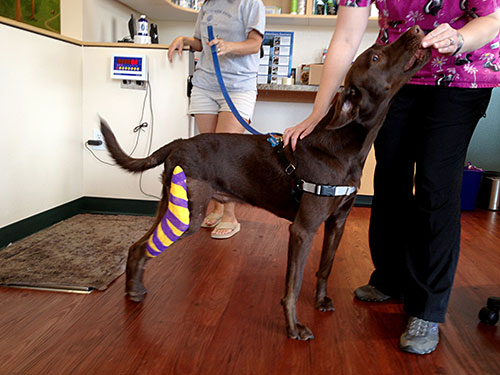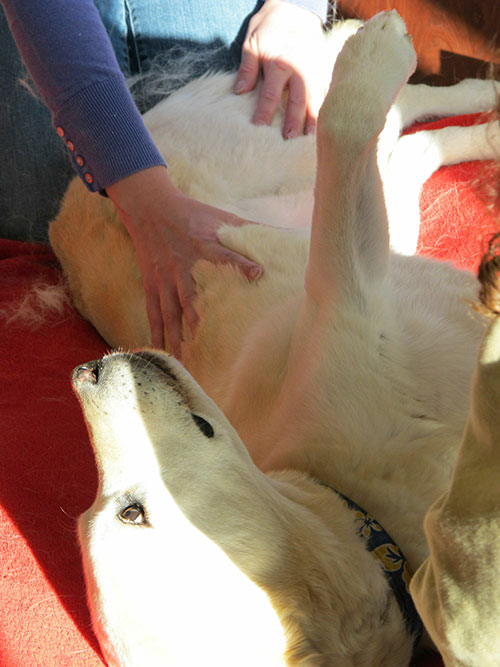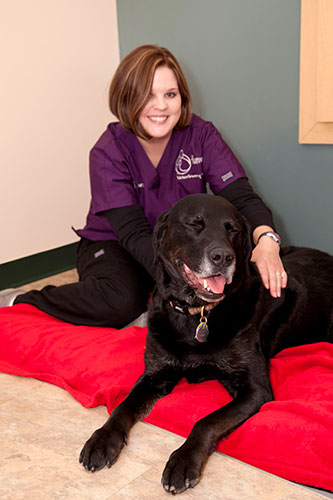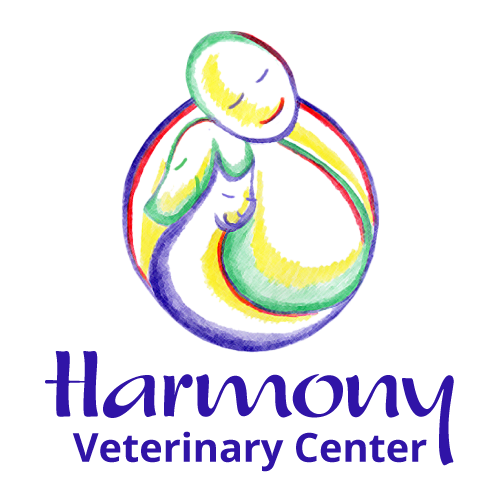Rehabilitation Therapy

When a person is recovering from an injury or has a neurologic or orthopedic problem, they go to physical therapy. During physical therapy a trained therapist works with the weak and damaged tissues to strengthen them and help the patient recover function more quickly. We can do the same with our canine and feline patients. Called rehabilitation in the veterinary world, this emerging field can help animals recover after surgery or injury, and can help animals with arthritis and other chronic diseases live longer, happier lives.
Rehabilitation uses a variety of techniques. These include:
- Ultrasound: High frequency ultrasound waves applied to the skin work their way into the deeper muscles and tendons to relieve spasms, improve blood flow and promote healing.
- Electrical stimulation: Mild electrical current is applied to the pads attached to the skin to help stimulate weak or poorly functioning nerves and muscles.
- Strengthening exercises, such as the fitball, cavaletti poles, and others can help strengthen muscles, improve balance, and increase overall fitness.
- Home exercises can help maintain progress between appointments.
- Underwater treadmill uses a treadmill in a box that can be filled with varying amounts of water, which helps support the body weight and make walking easier. The resistance of the water helps build muscle strength, while the support of the water allows weak patients to walk properly.
- Swimming therapy allows a patient to exercise without having to bear weight on painful or weak limbs.
Our trained veterinary rehabilitation therapist will work with your veterinarian to design a rehabilitation plan that is right for you and your pet.
Watch Mr. Sparky, a Dachshund who had a blood clot block his spine and could not walk, progress through his rehabilitation:
Massage Therapy
Like us, our canine and feline companions experience aches and pains throughout their lives. Massage therapy performed by our professionally trained veterinary massage therapist is a great way to help them feel better, reduce the need for pharmaceutical pain medication, and keep a healthy activity level through their old age.

Dogs and cats are very good at hiding pain, as this is how they survive in the wild. Many of the signs of pain can be subtle such as a twitch in the back, a slightly altered gait, or reluctance to go upstairs. As these early symptoms continue or progress, they cause even more unseen problems throughout the body.
For example, a young dog with hip dysplasia may run around having fun like any other dog but he is compensating for his weak hips by over-using other muscles and placing more strain on his upper body. Over time he will start to slow down or possibly injure himself, causing a trip to the veterinarian where it is discovered that the likely cause of his upper body injuries started with the hip dysplasia that he has been compensating for over the years.
Massage is part of a comprehensive treatment series utilized at Harmony Veterinary Center to release the muscle tension, pain, and get this dog moving fluidly again. The list of ailments that are responsive to massage therapy can be long, but the most common are:
- Arthritis
- Chronic pain
- Decreased mobility
- Musculoskeletal injuries, disorders or over-use
- Neurological injuries or abnormalities
- Pets who have suffered abuse or neglect
- Post-surgical patients
- Weekend warrior syndrome – over-using untrained muscles
When performed as part of a comprehensive treatment program, massage therapy can enhance a pet’s recovery time, decrease pain, reduce secondary injuries, and improve range of motion and circulation within the body. Other benefits of massage are:
- Relaxation
- Increased quality of life
- Calms and relaxes the mind, body and spirit
- Enhances the human-animal bond and trust
- Breaks down scar tissue
- Decreases inflammation
- Calms and reconnects damaged nerves
- Increases mental alertness and clarity
- Prevents and relieves muscle spasm
- Strengthens the immune system
- Relieves pain
- Promotes tissue healing
What you can expect during a massage visit for your pet

Many people have had a massage of their own, a nice relaxing day at the spa or something more intense after an accident or for a specific injury. Canine and feline massage is very similar, however without the oils and lotions! Our veterinarians will often recommend that your pet get a massage after performing a thorough exam and determining that it will be safe for your pet.
Our certified veterinary massage therapist will begin by consulting you and your veterinarian to get to know your pet. Then she will take time to get to know your pet and let him or her get comfortable with the new experience. Often dogs and cats are nervous during their first session but quickly learn to love massage. If there is only one specific area that is of concern to your dog or cat, the therapist will often start massaging in a non-problematic or non-painful area to introduce massage and gradually work her way toward the troubled area.
Massage is generally charged by the session rather that by the hour; this takes into account the many different sizes of pets. The goal is for an hour of massage but on very small pets an hour may be too long for them to tolerate. We also offer several different types of massages and even have massage packages to help reduce the cost for our chronic pain patients. Please speak with your veterinarian about how many and what type of massage will be the most beneficial for your pet.
You are encouraged to stay with your pet and meet with the therapist to give her an overview of your pet’s concerns. The therapist will also teach you home care techniques, if you are interested, to help extend the beneficial effects between sessions. However, you do not have to stay with your pet during his or her massage and many pets enjoy the time away from mom or dad.
About Our Rehabilitation/Massage Therapist
Jamie Gartenmann CVT, CCRP, CCMT, CMT is our professional massage and rehabilitation therapist on staff. She loves to help ease your pet’s discomfort and get him or her quickly on the road to recovery. Jamie is a certified veterinary technician with extensive knowledge of canine and feline anatomy. She is a graduate of Bel-Rea Institute of Animal Technology (CVT), Boulder College of Massage Therapy (CCMT, CMT), and the University of Tennessee – Animal Rehabilitation Therapy (CCRP). Jamie will work with you and your veterinarian to ensure that your pet is properly taken care of.
